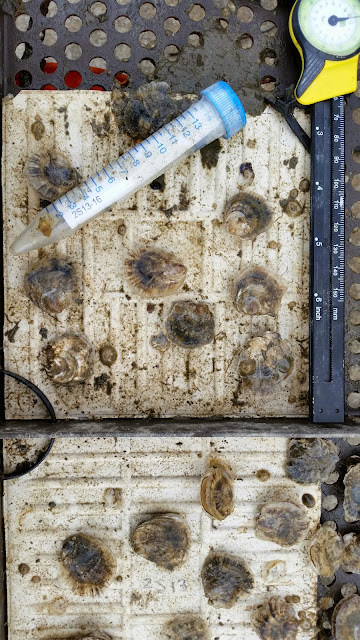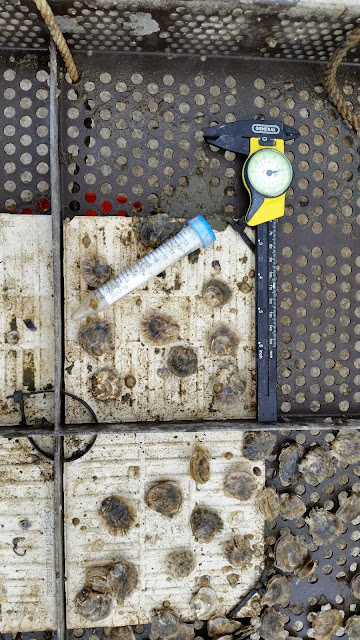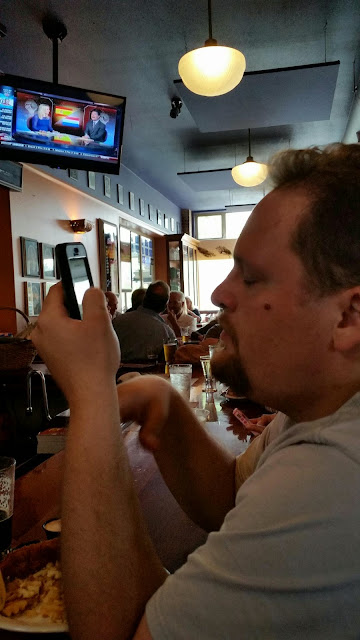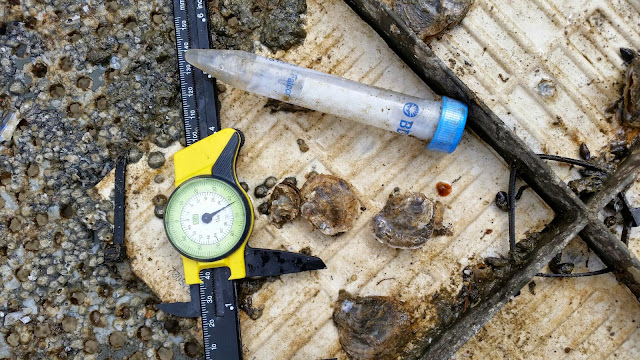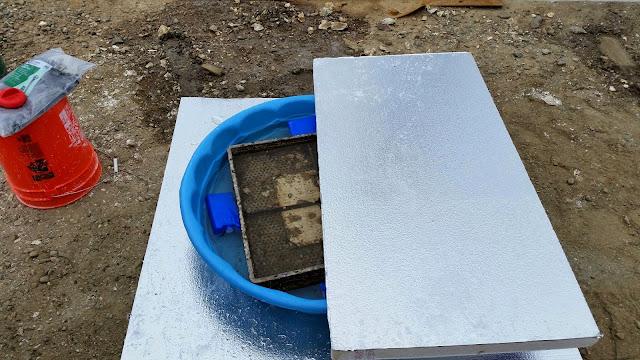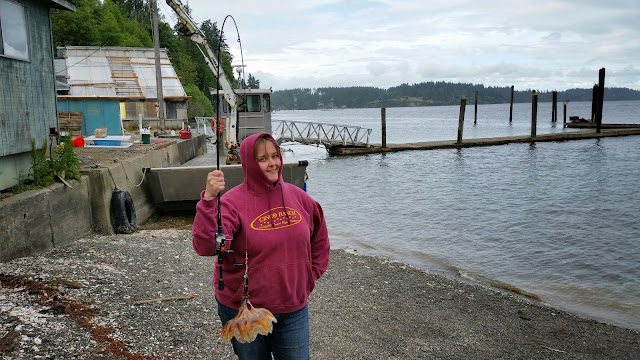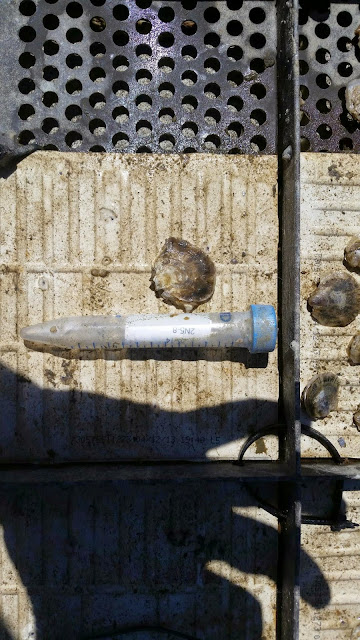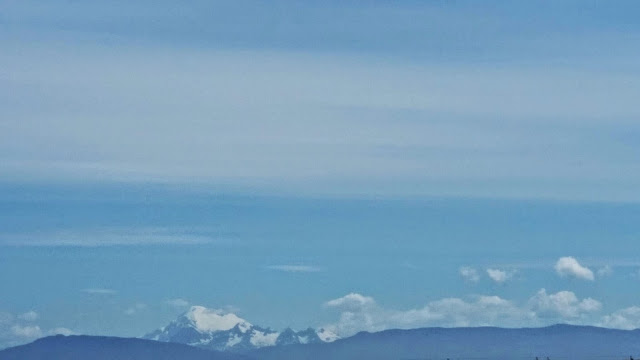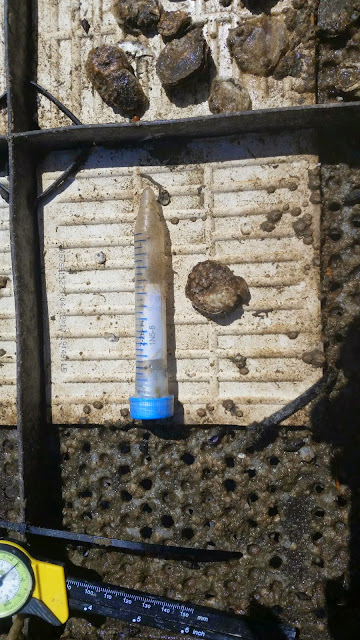Monday, June 16, 2014
Temperature Logger Readings from May to Mid June 2014
Friday, June 13, 2014
6 13 2014. Fidalgo repro check
Anacortes wa
Mid 60s partly cloudy lite rain
Participants: Sean Bennett and Jake Heare
Used the anesthesia sop with insulation on the treatment group. Temps stayed steady due to insulation and weather. Found multiple brooders in only one population. If you can guess which pop, you get a sticker.
Numbers as follow:
Temps in c
Pretreatment
Initial. 7
45 min. 7
1.5 hrs. 10
Treatment
Initial. 6
45 min. 6
1.5 hrs. 6
2.25 hrs. 6
Recovery
Initial. 7
45 min. 8
1.5 hrs. 9
Salinity in ppt
Pretreatment. 27
Treatment. 66
Recovery. 26
2N1-4
Brood. 0
Gaping. 68
Dead. 1
Closed. 27
2S13-16
Brood. 7
Gaping 83
Dead. 1
Closed. 3
Brooders
# size. Sick
1. 30. W
2. 26. W
3. 26. W
4. 25. W
5. 26. W
6. 28. W
7. 25. W
2H5-8
Brood. 0
Gaping. 72
Dead. 0
Closed. 27
Lots of males with semen. Expect more brooders next week.
Thursday, June 12, 2014
6 12 2014 oyster bay repro
Pretreatment
Initial. 15
45 min. 15
1.5 hrs. 15
Initial. 13
45 min. 13
1.5 hrs. 13
2.25 hrs. 13
Initial. 13
45 min. 13
1.5 hrs. 13
Pretreatment. 26
Treatment. 64
Recovery. 26
1S13-16
Brood. 3
Gaping. 63
Dead. 11
Closed. 6
# size. Sick
1. 27. W
2. 26. W
3. 19. W
Brood. 2
Gaping 48
Dead. 8
Closed. 1
# size. Sick
1. 32. Grey
2. 20. W
Brood. 1
Gaping. 86
Dead. 8
Closed. 1
# size. Sick
1. 19. W
Wednesday, June 11, 2014
6 11 2014 Manchester Repro
Temps Mid 60's to High 70s
Sunny
Participants: Joelle Blais and Jake Heare
Used the Anesthesia SOP to check for brooding larvae. I modified this per Steven and Brent's suggestions to temperature control via adding ice blocks to the solution as well as insulate the tub with 2 inch styrofoam insulation with foil top and bottom. Much to my surprise not only did the insulation work, kept water within 1 degree of ambient with out ice blocks, it actually lowered the temps of the treatment when ice blocks were added (2 degrees below ambient). I believe this insulation and ice blocks method will be the way to go from here on out. Even on the warmest days I see it insulating the tubs very well.
Numbers as follow:
Temps in C
Pretreatment
Initial 9
45 min 15
1.5 hrs 19
Treatment
Initial 11
45 min 11
1.5 hrs 10
2.25 hrs 8
Recovery
Initial 11
45 mins 13
1.5 hrs 15
Salinity in ppt
Pretreatment 25
Treatment 65
Recovery 25
Brood Collection
4H1-4
Brood 0
Gapin 63
Dead 2
Closed 31
4S9-12
Brood 0
Gaping 49
Dead 12
Closed 37
4N9-12
Brood 0
Gaping 41
Dead 8
Closed 12
One male in the 4H group had sperm within its shell. I assume these animals are attempting to spawn though water temps seem to be below expectation.
Friday, June 6, 2014
6 6 2014 fidalgo repro check
Followed the anesthesia sop at fidalgo. Attempted to keep the treatment Temps around 11 c where the ambient water was. The direct sun had other plans. Will need way way way more gel bags. even then it might be more than can actually fit in the tub with the samples.
Also to my and hopefully everyone else's surprise. I found a Brooding oyster! If you can guess which population it came from before you look below, you are one smart cookie.
Numbers as follow
Temps
Pretreatment
Initial. 10
45 min. 15
1.5 hrs. 19
Treatment
Initial. 11
45 min. 16
1.5 hrs. 17
2.25 hrs. 19
Recovery
Initial 10
45 min. 15
1.5 hrs. 19
Salinity
Pretreatment. 20
Treatment. 63
Recovery. 21
Brood collection
2S9-12
Brood. 0
Gaping. 53
Dead. 1
Closed. 43
2H13-16
Brood. 0
Gaping. 58
Dead. 0
Closed. 33
2N5-8
Brood. 1
Gaping. 59
Dead. 2
Closed. 36
Brooders
# size(mm). Sick
1. 31. W
Lots of nukaluka in the water. Some may have been collected with brooding larvae. May muddy up counting.
Picture of brooders follows.
Thursday, June 5, 2014
6 5 2014 oyster bay repro check
Pretreatment.
Initial. 13
45 min. 16
1.5 hrs. 16
Initial. 10
45 min 17
1.5 hrs. 16
2.25 hrs. 16
Initial 13
45 min. 17
1.5 hrs 17
Pretreatment. 26
Treatment. 63
Recovery. 26
1S13-16
Brood. 2
Gaping. 60
Dead. 12
# size. Sick
1. 23. W
2. 29. W
Brood. 2
Gaping 79
Dead. 7
# size. Sick
1. 25. W
2. 24. Grey
Brood. 1
Gaping. 52
Dead 7
# size. Sick
1. 30. W
Wednesday, June 4, 2014
6 4 2014 Manchester Repro Check
 |
| Brooding Olys in Hatchery |
 |
| Flow through with bong screen to catch Oly larvae. |
 |
| Various flowthroughs for brooding Olys |
 |
| Oly larvae (invisible) |
 |
| Larval Tanks and Ryan's Gesticulation |
 |
| Chipmunk |
 |
| Baby Goslings! |
 |
| Clam Bay with glassy surface waters! |



